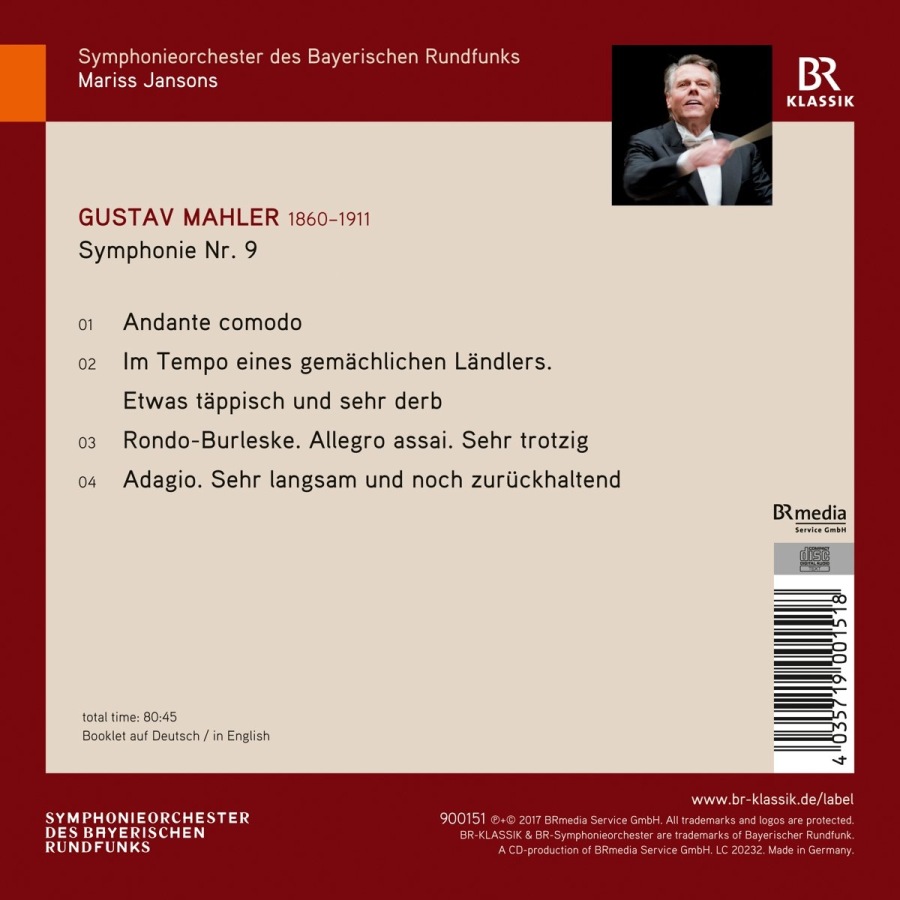
classical music distribution


(Produkt nie został jeszcze oceniony)


kompozytor
Mahler, Gustav
tytuł
Mahler: Symphony No. 9
wykonawcy
Symphonieorchester des Bayerischen Rundfunks;
Jansons, Mariss
Jansons, Mariss
nr katalogowy
BR 900151
opis
Gustav Mahler's Ninth Symphony is primarily regarded as the composer’s reaction in the summer of 1908 to the diagnosis of a heart ailment, which he received just before writing the first sketches for the work. Mahler was deeply distraught and cannot have known how few years he still had left to live. His processing and exploration of his life experiences, and of valedictions, the meaning of life, death, salvation, life after death and love, always took place in and through his music. The Ninth Symphony was composed between 1909 and 1910 in Toblach, in a kind of creative frenzy, and was first performed in Vienna on June 26, 1912 by the Vienna Philharmonic, under the baton of Bruno Walter. Mahler had already died on May 18, 1911, and was no longer able to experience the premiere of his last completed work. Willem Mengelberg, the first ardent conductor of the composer’s works, wrote in his score: "Mahler's soul sings its farewell!" Mahler's Ninth Symphony represents the culmination of a development process. The progressive chromaticism and maximum utilization of the tonal are here taken to their limits - and, for the first time, beyond them. Indeed, the two movements that frame the work, in particular, depart from the tonal entirely, pointing clearly to the dawn of a new musical epoch. Alban Berg even called this symphony "the first work of New Music". The Munich concert event of October 2016 is now being released on CD by BR-KLASSIK – it is an outstanding interpretation of one of the most important compositions of the international symphonic repertoire of the early 20th century.
nośnik
CD
gatunek
Muzyka klasyczna
producent
BR Klassik
data wydania
01-02-2017
EAN / kod kreskowy
4035719001518
Produkt nagrodzony:
ICMA 'Nominee' (2017)
MusicWeb International: 'Recording of the Month' (2017)

(Produkt nie został jeszcze oceniony)
cena 58,00 zł
lubProdukt na zamówienie
Wysyłka ustalana indywidualnie.
Darmowa wysyłka dla zamówień powyżej 300 zł!
Darmowy kurier dla zamówień powyżej 500 zł!
sprawdź koszty wysyłkiProduktu jeszcze nie zrecenzowano, chcesz być pierwszy?
Klienci, którzy kupili ten produkt, kupili również
Lalande, Michel-Richard de
Lalande: Les Fontaines de Versailles; Le Concert d’Esculape
CPO 555 097-2
Arnold, Malcolm
Arnold: Cello Concerto, Symphony for Strings, Fantasy for Recorder and String Quartet
8.572640
Pozostałe płyty tego kompozytora
Bruckner, Anton, Mahler, Gustav
WYCOFANY Bruckner: Chamber Symphony; Mahler: Symphony No. 10 (Andante - Adagio)
ETP 008
Beethoven, Ludwig van, Mahler, Gustav
The Mahler Album - Mahler: Adagietto from Symphony no. 5 & Adagio from Symphony no. 10, Beethoven: String Quartet no. 11
CCS SA 31511
Pozostałe płyty tego wykonawcy
Saint-Saëns, Camille, Poulenc, Francis
Saint-Saëns: Symphony No.3 "Organ"; Poulenc: Organ Concerto
900178
Mozart, Wolfgang Amadeus
Mozart: Piano Concertos 21 & 23 / Bartok: Piano Concerto No. 3
PRD 250326
Napisz recenzję dla: Mahler: Symphony No. 9
Zapytaj o dostępność produktu
Twoje zapytanie:
Odpowiemy na adres:
Produkt został dodany do koszyka

Mahler, Gustav
Mahler: Symphony No. 9
1 szt











































